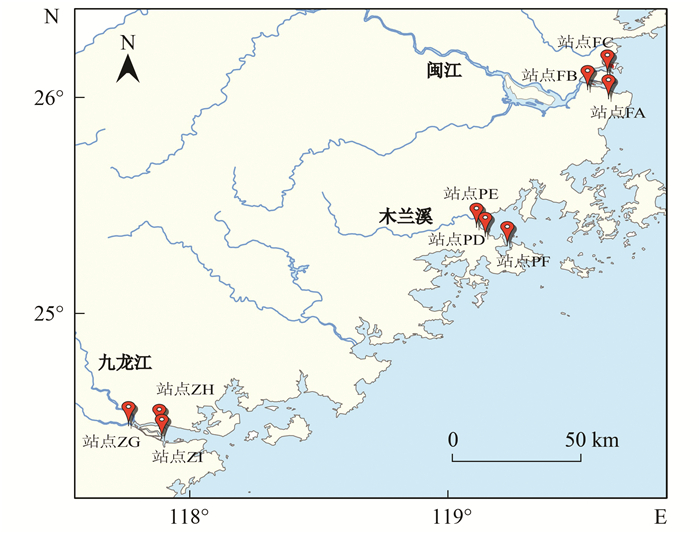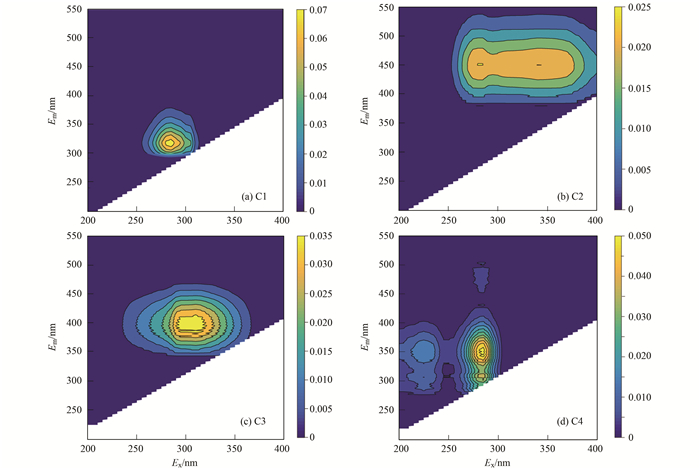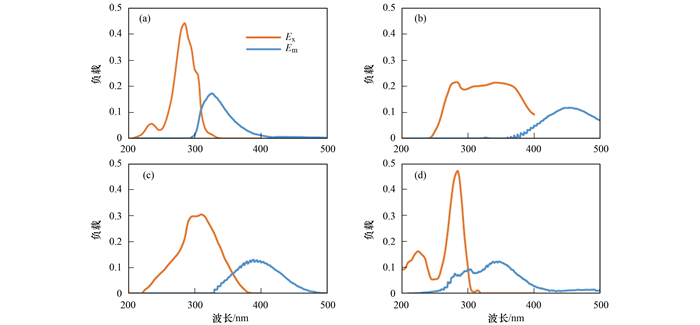2. 福建师范大学湿润亚热带生态地理过程教育部重点实验室, 福州 350007;
3. 福建师范大学地理科学学院, 福州 350007;
4. 福州大学环境与资源学院, 福州 350116;
5. 福建师范大学生态学博士后科研流动站, 福州 350007
2. Key Laboratory for Humid Subtropical Eco-geographical Process of the Ministry of Education, Fujian Normal University, Fuzhou 350007, China;
3. School of Geographical Sciences, Fujian Normal University, Fuzhou 350007, China;
4. School of Environment and Resource, Fuzhou University, Fuzhou 350116, China;
5. Postdoctoral Research Station of Ecology, Fujian Normal University, Fuzhou 350007, China
溶解性有机质(dissolved organic matter, DOM)是广泛存在于天然水生环境的有机物质, 对水体的碳循环有重要影响[1, 2].作为水生生态系统中一种重要的化学组分, DOM不仅与水体污染物质的迁移转化、生物降解等过程密切相关, 同时对水体水质及富营养化的演化等有重要影响[3, 4].有色溶解性有机质(chromophoric dissolved organic matter, CDOM)作为溶解性有机质(DOM)的最重要组成部分, 可全面揭示水体DOM的动态、组分及其来源等[5].
三维荧光-激发发射矩阵光谱(EEMs)是近年来被广泛应用于CDOM来源及动力学特征研究的一种荧光光谱分析技术[6, 7], 通过平行因子法(parallel factor analysis, PARAFAC)解谱提取荧光特征, 可对不同荧光组分进行定性和定量分析[8], EEMs-PARAFAC已成为研究水环境中溶解有机物性质及动力学特征的重要手段[9, 10].近年来, 国内外学者利用EEMs-PARAFAC对各种天然水体中CDOM的组成及来源开展了一系列研究. Yao等[11]研究了太湖及其支流不同成分CDOM的来源, 发现存在2种色氨酸组分, 2种腐殖质组分和1种酪氨酸样组分, 认为CDOM受地质和相关土地利用方式差异的影响. Guo等[12]在九龙江河口区通过5次流域尺度调查确定了九龙江河口水体CDOM的2种类腐殖质及3种类蛋白质样荧光组分.肖隆庚等[13]在中国南海海域CDOM的三维荧光峰中只观测到了1种类腐殖质及1种类蛋白质, 认为CDOM为海洋自生来源, 其主要贡献为海洋生物活动.而对于人工模式下河口陆基养虾塘水体中CDOM的组成及来源的研究却鲜见报道.
据联合国粮食及农业组织数据显示, 目前世界水产养殖塘的面积高达87 500 km2[14], 中国的水产养殖产量占世界的70%, 淡水池塘养殖产量占中国水产养殖总量的41.5%[15].福建省是中国东南沿海虾类的主要养殖区之一, 2014年养虾塘面积约占全国养殖面积的7%, 位居全国第4[16].养殖塘作为一种强人为干扰下的水生生态系统, 其水体污染程度会给水产业及周围环境带来一系列深远的影响.基于此, 本研究利用EEMs-PARAFAC技术对福建省主要河口区滨海陆基养虾塘水体CDOM的三维荧光光谱特性进行分析, 考察了其组成成分及来源属性, 通过探究亚热带河口养虾塘水体CDOM在养殖塘水生生态系统的环境行为特性, 以期为水质状况和水体中营养盐的迁移转换提供科学依据.
1 材料与方法 1.1 研究区概况本研究以福建省3条主要河流入海处作为研究区, 自北向南分别为闽江、木兰溪和九龙江, 河口区内遍布滩涂水产养殖塘. 3个河口地区均属于南亚热带季风气候区, 年均温19.6~21℃, 年均降雨量均为1 300 mm以上[17~19].在3个河口分别选择3个具有代表性的陆基养殖塘(图 1), 养殖水均源于附近河水或海水.养殖塘内的产品为南美白对虾(Litopenaeus vannamei).该品种于每年5月投放虾苗, 10~11月将虾全部收获.采样期为2017年7月, 采样时间正是对虾生长旺盛的季节, 对虾食量增加, 消化和吸收也相对比较快.

|
图 1 研究区和采样点分布示意 Fig. 1 Location of the study area and sampling plots |
2017年7月23~28日, 在9个养虾塘分别采集塘底距离沉积物-水界面10 cm水样, 每个养殖塘设置3个重复.水样采集后立即装入预先处理的棕色玻璃瓶中, 并盖上丁基胶塞, 用铝箔箍好瓶盖, 放入装有冰袋的保温箱中冷藏保存并运回实验室.回到实验室后, 所有水样经450℃灼烧至恒重, 用0.45 μm玻璃纤维滤膜(Whatman® GF/F)过滤后避光4℃冷藏保存备用.本实验中所用容器预先经稀盐酸浸泡过夜, 并用超纯水洗涤后烘干使用, 实验中所用试剂均为分析纯.
水样中DOC浓度使用TOC-VCPH总有机碳分析仪(岛津, 日本)测定分析, CDOM的三维荧光光谱测定在F-7000型荧光分光光度计(日立, 日本)上进行, 仪器开机后等待30 min, 以此来减少由于仪器不稳定带来的误差.激发与发射狭缝宽度分别为5 nm和10 nm, 扫描波长范围为Ex为220~450 nm, 步长5 nm, Em为230~650 nm, 步长2 nm.每次实验均对超纯水进行3次拉曼光谱的扫描, 从而监测仪器的稳定性.
1.3 数据处理及分析利用MatlabR2016b软件的DOMFluor工具箱对三维荧光光谱进行平行因子法分析.其次, 由于考虑到信噪比的影响, 所以激发波长250 nm和发射波长300 nm以下的数据不参与计算[20], 初步确定荧光组分数并且通过利用折半分析(Split-half analysis)来检验结果的可靠性.利用三维荧光数据计算得出荧光指数FI和自生源指标BIX以及腐殖化指标HIXa、HIXb, 各个组分的荧光强度均利用FMAX(RU)来表示[21], 结果见表 1.养虾塘水体的荧光特征与水质参数间相关关系采用SPSS 22.0中Pearson进行相关分析, 显著水平设置为0.05.
|
|
表 1 亚热带河口地区养虾塘水体主要性质 Table 1 Parameters in the water of shrimp ponds in the subtropical estuary |
2 结果与分析 2.1 养虾塘水体CDOM的三维荧光光谱特征
采用PARAFAC对本次采样点27个CDOM样的三维荧光光谱特征进行分析, 结果显示亚热带3个河口区滨海陆基养虾塘水体荧光特征呈现4个荧光组分, 包括2种类腐殖质和2种类蛋白质, 荧光团组分和特征见表 2. 图 2和3分别为养虾塘水体CDOM激发和发射波长及载荷图.
|
|
表 2 亚热带河口地区养虾塘水体中CDOM荧光团组分特征 Table 2 Characteristics of DOM fluorophores in the water of shrimp ponds in the subtropical estuary |

|
图 2 亚热带河口地区养虾塘水体CDOM的4个组分EEMS Fig. 2 Four components of CDOM in the water of shrimp ponds in the subtropical estuary |

|
图 3 亚热带河口地区养虾塘水体CDOM的4个组分载荷 Fig. 3 Four component loads of CDOM in the water of shrimp ponds in the subtropical estuary |
组分C1(Ex/Em, 285 nm/325 nm)、C4(Ex/Em, < 250 nm, 285/347 nm)均属于类蛋白质荧光组分, 其中C1具有一个激发峰和发射峰, 位于传统的B峰区域[22], 主要体现的是类酪氨酸类蛋白物质.组分C4具有2个激发峰和1个发射峰, 其中激发与发射波长与色氨酸单体的荧光峰类似[20], 短波与长波激发分别对应于传统的R峰(225 nm/342 nm)与T峰(275 nm/342 nm)[1, 9], 主要体现的是类色氨酸类蛋白物质.
组分C2(Ex/Em, 280 nm/453 nm)、C3(Ex/Em, 310 nm/389 nm)均属于类腐殖质荧光组分, 其中C2具有一个激发峰和发射峰, 位于传统的A峰位置, 主要为分子量较大的芳香氨基酸腐殖物质的紫外光类腐殖质.组分C3具有一个激发峰和发射峰, 其主要是和富里酸相类似的海洋类腐殖质, 位于传统的M峰(290~310 nm/370~410 nm)区域[1], 一般认为其代表了海洋来源的长波类腐殖质荧光峰[26].
2.2 养虾塘水体CDOM的三维荧光组分比例对亚热带3个河口区滨海陆基养虾塘水体CDOM的荧光组分进行分析发现, 养虾塘水体CDOM主要成分均为C1和C4两种类蛋白荧光组分(图 4), 占比例分别为21.13%~49.02%和30.18%~40.05%, 而C2和C3类腐殖质荧光组分所占比例较小, 占比例分别为7.94%~20.78%和8.24%~30.08%.

|
图 4 不同养虾塘水体CDOM的荧光组分比例 Fig. 4 Fluorescence ratios of CDOM in different shrimp ponds |
荧光指数(FI)是Ex=370 nm时, Em在470 nm和520 nm处的荧光强度比值, 常用来表征溶解性有机质中腐殖质的来源[21]. FI>1.9时主要源于水体自身微生物活动, 自生源特征明显; FI<1.4时以外源输入为主, 水体自身生产力贡献相对较低[28, 29].自生源指标BIX反映了CDOM自生源的相对贡献, BIX的范围在0.6~0.8之间表示自生源贡献较少, 大于1.0时说明CDOM降解程度高, 其自生源组分特征明显[30].腐殖化指数HIX(HIXa和HIXb)是能够表征有机质腐殖化程度的重要指标(HIXb为消除内滤效应干扰后的改进值), 高HIX值表明有机质腐殖化程度较高[31].由图 5可以看出, 本研究中3个河口区养虾塘水体FI的范围位于1.53~1.78(均值为1.65), 自生源指标BIX的范围是1.0~1.34(均值为1.06).腐殖化指标HIXa在0.69~3.10之间(均值为1.84), HIXb值在0.41~0.71之间(均值为0.63).

|
图 5 亚热带河口地区养虾塘水体CDOM的3种荧光指标 Fig. 5 Three fluorescence indicators of CDOM in the water of shrimp ponds in the subtropical estuary |
CDOM组分和各荧光光谱指标、水体理化性质进行相关性分析(表 3), 发现类蛋白质组分(C1、C4)之间、类腐殖质组分(C2、C3)之间均极显著正相关(P < 0.01).盐度与CDOM各组分之间均存在显著的负相关关系(P < 0.05), 腐殖化指数HIX(HIXa、HIXb)与类蛋白质组分(C1、C4)均呈现极显著的负相关(P < 0.01).
|
|
表 3 亚热带河口地区养虾塘水体的荧光特征与水质参数相关性分析1) Table 3 Correlation analysis of fluorescence characters and water quality parameters of shrimp ponds in the subtropical estuarine area |
3 讨论 3.1 养虾塘水体CDOM的组分分析
C1类酪氨酸类蛋白物质主要由微生物降解产生[32], 它与CDOM中的芳环氨基酸结构有关, 在河流和海洋的CDOM中均有这类荧光峰的出现[33]. C4类色氨酸类蛋白物质被认为是陆生植物或土壤有机质自生源产生过程生成的蛋白质成分或降解较少的缩氨酸[5, 34]. C2紫外光类腐殖质被认为与腐殖质结构中的羰基和羧基有关, 来源以陆源为主, 也有自生源, 具有易光降解、生物可利用性差的特点[1, 5, 33]. C3一般被认为是长波类腐殖质荧光峰, 但郭卫东等在九龙江河口的研究表明M峰并不代表海洋来源的专有特征峰, 在陆地淡水中也发现其存在, 且可能是从陆地输入到海洋中荧光物质的主要组分[9].在流动水体中类腐殖酸荧光峰的形成主要来自外源输入[35], 既有研究表明闽江及九龙江水体溶解性有机质中主要为类腐殖质C2和C3, 其中类蛋白物质成分较低[9, 20].对本研究区域的养虾塘水体CDOM的荧光组分进行分析发现, CDOM主要成分均为类蛋白荧光组分, 而类腐殖质荧光组分所占比例较小.造成该现象的原因主要是由于养虾塘这一特殊水体环境, 每个河口区养虾塘养殖水均源于附近河水或海水, 养殖中期为了避免对虾产生应激或者受刺激导致的非正常脱壳情况, 需保持水体生态环境的相对稳定, 实施较为封闭的水环境管理, 并没有与外界水体发生明显交换.采样时间为对虾生长旺盛时期, 在高密度养殖量和高饵料投放的模式下, 大量残饵、虾的代谢物等导致水体中有机质维持在相对较高的水平[36, 37].除此之外, 该时期较高的水温有效提高了水体微生物活性, 促进水体有机物和饵料残体分解[38, 39].这些生物活动形成的有机质在细菌等微生物及生物细胞残留的蛋白酶作用下, 含有的大量蛋白质被水解进而释放出氨基酸组分, 导致水体中类色氨酸及类酪氨酸等类蛋白质荧光组分浓度显著增加[40].
3.2 养虾塘水体CDOM的来源分析一般认为CDOM组分的来源主要分外源和内源, 外源主要是由细菌和真菌降解的流域土壤当中高等动植物残体所形成, 多表现为类腐殖质峰占据绝对优势, 内源主要是指由水体中浮游生物、水生细菌以及藻类等生物活动所产生, 多表现为类蛋白峰占据绝对优势[41].而在本研究中, CDOM的外源主要来自于养殖饵料的投放输入, 而内源则主要来源于虾的觅食、排泄、死亡等活动.荧光指数FI和自生源指标BIX以及腐殖化指标HIX是评估水体中CDOM来源的重要指标[42].由图 5所示, FI的范围位于1.53~1.78(均值为1.65), 表示既有外源输入又有内源的贡献, 类蛋白质组分占主要优势则进一步说明了内源的贡献. BIX的范围是1.0~1.34(均值为1.06)说明了较强的生物活动来源. HIXa值在0.69~3.10之间(均值为1.84), HIXb值在0.41~0.71之间(均值为0.63), 根据HIXa和HIXb的范围, 认为养殖塘水体具有较强的生物来源属性, 腐殖化程度较低[43].根据3个指标的意义, 均可推测养虾塘水体中CDOM主要由生物活动相互作用产生, 高密度的虾生物量是CDOM来源的主要贡献.
类蛋白质组分(C1、C4)之间、类腐殖质组分(C2、C3)之间均极显著正相关(P < 0.01), 显示了它们的共源性; 类腐殖质组分(C2、C3)与类蛋白组分(C1、C4)之间也呈极显著相关性(P < 0.01), 刘堰杨等[5]在川西高原河流水体的研究也表明类腐殖质与类蛋白质之间具有密切的联系.既有研究表明类酪氨酸和类色氨酸可能有相同的来源, 而陆源类腐殖质荧光峰及海洋来源类腐殖质荧光峰由相同荧光团产生[44].程远月等[45]在九龙江河口区研究发现溶解性有机质相对荧光强度随盐度降低而增加, 表现出很好地从海洋到内陆增加的趋势.盐度变化影响水体微生物活性, 从而导致水体DOC浓度因有机物分解速率下降而降低[36].
在不同水环境中, DOC与CDOM总是能呈现出显著正相关关系[35, 46].本研究中DOC与CDOM中的类腐殖质组分(C2、C3)均呈现极显著的相关性(P < 0.01).在大西洋沿岸海域和西地中海, 以及中国长江重庆段的河水中也发现了类似现象[47, 48].腐殖酸是广泛存在于天然水体等自然界中的天然高分子聚合物, 分子结构较复杂, 难以被生物降解[49].天然腐殖酸是环境污染物的各种络合剂和吸附剂, 对各种污染物的环境行为、毒性和生物有效性有重要的作用[50].类腐殖质荧光与DOC存在正相关关系表明腐殖酸组分是DOC的重要组成成分.养殖塘水体的腐殖酸可能主要来自养殖塘虾类残骸的腐烂分解, 且腐解时间越长, 虾体残骸生物量越大, DOC分析结构越复杂, 腐殖化程度越高.在光降解、微生物降解等作用影响下, 组分中腐殖酸、富里酸、蛋白类物质以及一些非荧光物质在DOC中所占比例不同[51], 这些都导致荧光强度与DOC之间关系存在差异.
4 结论(1) 亚热带3个河口区滨海陆基养殖塘水体CDOM主要包括4个组分, 即类蛋白质荧光组分C1(Ex/Em, 285 nm/325 nm)及C4(Ex/Em, <250 nm, 285 nm/347 nm)及类腐殖质荧光组分C2(Ex/Em, 280 nm/453 nm)、C3(Ex/Em, 310 nm/389 nm), 其中类蛋白质组分是养殖塘水体CDOM主要组成部分.
(2) 荧光指数FI、自生源指标BIX以及腐殖化指标HIX均表明3个河口区滨海陆基养虾塘水体CDOM中腐殖质含量低, 生物细菌活动较多, 水体中CDOM主要来源于高密度的虾生物量及其觅食、排泄、死亡等活动过程.
(3) 类蛋白质组分(C1、C4)与类腐殖质组分(C2、C3)之间均存在着相同的来源.盐度与CDOM各组分之间均存在显著的负相关关系, DOC与CDOM中的类腐殖质组分(C2、C3)均呈现极显著的正相关.
| [1] | Stedmon C A, Markager S. Resolving the variability in dissolved organic matter fluorescence in a temperate estuary and its catchment using PARAFAC analysis[J]. Limnology and Oceanography, 2005, 50(2): 686-697. DOI:10.4319/lo.2005.50.2.0686 |
| [2] | Battin T J, Luyssaert S, Kaplan L A, et al. The boundless carbon cycle[J]. Nature Geoscience, 2009, 2(9): 598-600. DOI:10.1038/ngeo618 |
| [3] | Park J H, Kalbitz K, Matzner E. Resource control on the production of dissolved organic carbon and nitrogen in a deciduous forest floor[J]. Soil Biology and Biochemistry, 2002, 34(6): 813-822. DOI:10.1016/S0038-0717(02)00011-1 |
| [4] |
吴丰昌, 王立英, 黎文, 等. 天然有机质及其在地表环境中的重要性[J]. 湖泊科学, 2008, 20(1): 1-12. Wu F C, Wang L Y, Li W, et al. Natural organic matter and its significance in terrestrial surface environment[J]. Journal of Lake Sciences, 2008, 20(1): 1-12. DOI:10.3321/j.issn:1003-5427.2008.01.001 |
| [5] |
刘堰杨, 秦纪洪, 刘琛, 等. 基于三维荧光及平行因子分析的川西高原河流水体CDOM特征[J]. 环境科学, 2018, 39(2): 720-728. Liu Y Y, Qin J H, Liu C, et al. Characteristics of chromophoric dissolved organic matter (CDOM) in rivers of western sichuan plateau based on EEM-PARAFAC analysis[J]. Environmental Science, 2018, 39(2): 720-728. |
| [6] | Wang C, Guo W D, Guo Z R, et al. Characterization of dissolved organic matter in groundwater from the coastal Dagu River watershed, China using fluorescence excitation-emission matrix spectroscopy[J]. Spectroscopy and Spectral Analysis, 2013, 33(9): 2460-2465. |
| [7] | Yamashita Y, Kloeppel B D, Knoepp J, et al. Effects of watershed history on dissolved organic matter characteristics in headwater streams[J]. Ecosystems, 2011, 14(7): 1110-1122. DOI:10.1007/s10021-011-9469-z |
| [8] |
陈永娟, 胡玮璇, 庞树江, 等. 北运河水体中荧光溶解性有机物空间分布特征及来源分析[J]. 环境科学, 2016, 37(8): 3017-3025. Chen Y J, Hu W X, Pang S J, et al. Spatial distribution characteristics and source analysis of dissolved organic matter in Beiyun River[J]. Environmental Science, 2016, 37(8): 3017-3025. |
| [9] |
郭卫东, 黄建平, 洪华生, 等. 河口区溶解有机物三维荧光光谱的平行因子分析及其示踪特性[J]. 环境科学, 2010, 31(6): 1419-1427. Guo W D, Huang J P, Hong H S, et al. Resolving excitation emission matrix Spectroscopy of Estuarine CDOM with parallel factor analysis and its application in organic pollution monitoring[J]. Environmental Science, 2010, 31(6): 1419-1427. |
| [10] | Yamashita Y, Jaffé R, Maie N, et al. Assessing the dynamics of dissolved organic matter (DOM) in coastal environments by excitation emission matrix fluorescence and parallel factor analysis (EEM-PARAFAC)[J]. Limnology and Oceanography, 2008, 53(5): 1900-1908. DOI:10.4319/lo.2008.53.5.1900 |
| [11] | Yao X, Zhang Y L, Zhu G W, et al. Resolving the variability of CDOM fluorescence to differentiate the sources and fate of DOM in Lake Taihu and its tributaries[J]. Chemosphere, 2011, 82(2): 145-155. DOI:10.1016/j.chemosphere.2010.10.049 |
| [12] | Guo W D, Yang L Y, Hong H S, et al. Assessing the dynamics of chromophoric dissolved organic matter in a subtropical estuary using parallel factor analysis[J]. Marine Chemistry, 2011, 124(1-4): 125-133. DOI:10.1016/j.marchem.2011.01.003 |
| [13] |
肖隆庚, 陈文松, 陈国丰, 等. 中国南海CDOM三维荧光光谱特征研究[J]. 环境科学学报, 2014, 34(1): 160-167. Xiao L G, Chen W S, Chen G F, et al. Fluorescence excitation-emission matrix spectroscopy of chromophoric dissolved organic matter in the South China Sea[J]. Acta Scientiae Circumstantiae, 2014, 34(1): 160-167. |
| [14] |
宋红丽, 刘兴土, 文波龙. 黄河三角洲养殖塘水-气界面CO2、CH4和N2O通量特征[J]. 生态环境学报, 2017, 26(9): 1554-1561. Song H L, Liu X T, Wen B L. Greenhouse gases fluxes at water-air interface of aquaculture ponds in the Yellow River Estuary[J]. Ecology and Environmental Sciences, 2017, 26(9): 1554-1561. |
| [15] |
朱林, 车轩, 刘晃, 等. 团头鲂池塘养殖生态系统晒塘阶段温室气体排放通量分析[J]. 农业工程学报, 2016, 32(3): 210-215. Zhu L, Che X, Liu H, et al. Greenhouse gas emissions of Megalobrama amblycephala culture pond ecosystems during sun drying of pond[J]. Transactions of the Chinese Society of Agricultural Engineering, 2016, 32(3): 210-215. |
| [16] |
陈金玲, 赖秋明, 苏树叶, 等. 精养虾池主要生态因子变化特点与相关性分析[J]. 南方水产科学, 2012, 8(4): 49-56. Chen J L, Lai Q M, Su S Y, et al. Study on variation characteristics and correlation analysis of major ecological factors in intensive shrimp ponds[J]. South China Fisheries Science, 2012, 8(4): 49-56. DOI:10.3969/j.issn.2095-0780.2012.04.008 |
| [17] | Luo M, Zeng C S, Tong C, et al. Kinetics of chemical and microbial iron reduction along an inundation gradient in a tidal marsh of the Min River Estuary, southeastern China[J]. Geomicrobiology Journal, 2015, 32(7): 635-647. DOI:10.1080/01490451.2014.950362 |
| [18] | Zhang J Q, Qi S H, Xing X L, et al. Organochlorine pesticides (OCPs) in soils and sediments, southeast China:a case study in Xinghua Bay[J]. Marine Pollution Bulletin, 2011, 62(6): 1270-1275. DOI:10.1016/j.marpolbul.2011.03.010 |
| [19] | Alongi D M, Pfitzner J, Trott L A, et al. Rapid sediment accumulation and microbial mineralization in forests of the mangrove Kandelia candel in the Jiulongjiang Estuary, China[J]. Estuarine, Coastal and Shelf Science, 2005, 63(4): 605-618. DOI:10.1016/j.ecss.2005.01.004 |
| [20] |
郭卫东, 杨丽阳, 王福利, 等. 水库型河流溶解有机物三维荧光光谱的平行因子分析[J]. 光谱学与光谱分析, 2011, 31(2): 427-430. Guo W D, Yang L Y, Wang F L, et al. Parallel factor analysis for excitation emission matrix fluorescence spectroscopy of dissolved organic matter from a Reservoir-Type River[J]. Spectroscopy and Spectral Analysis, 2011, 31(2): 427-430. DOI:10.3964/j.issn.1000-0593(2011)02-0427-04 |
| [21] | Cory R M, Miller M P, Mcknight D M, et al. Effect of instrument-specific response on the analysis of fulvic acid fluorescence spectra[J]. Limnology and Oceanography:Methods, 2010, 8(2): 67-78. DOI:10.4319/lom.2010.8.67 |
| [22] | Leenheer J A, Croué J P. Peer reviewed:characterizing aquatic dissolved organic matter[J]. Environmental Science & Technology, 2003, 37(1): 18A-26A. |
| [23] |
宋晓娜, 于涛, 张远, 等. 利用三维荧光技术分析太湖水体溶解性有机质的分布特征及来源[J]. 环境科学学报, 2010, 30(11): 2321-2331. Song X N, Yu T, Zhang Y, et al. Distribution characterization and source analysis of dissolved organic matters in Taihu Lake using three dimensional fluorescence excitation-emission matrix[J]. Acta Scientiae Circumstantiae, 2010, 30(11): 2321-2331. |
| [24] | Coble P G, Del Castillo C E, Avril B. Distribution and optical properties of CDOM in the Arabian Sea during the 1995 Southwest Monsoon[J]. Deep Sea Research Part Ⅱ:Topical Studies in Oceanography, 1998, 45(10-11): 2195-2223. DOI:10.1016/S0967-0645(98)00068-X |
| [25] |
甘淑钗, 吴莹, 鲍红艳, 等. 长江溶解有机质三维荧光光谱的平行因子分析[J]. 中国环境科学, 2013, 33(6): 1045-1052. Gan S C, Wu Y, Bao H Y, et al. Characterization of DOM(dissolved organic matter) in Yangtze River using 3-D fluorescence spectroscopy and parallel factor analysis[J]. China Environmental Science, 2013, 33(6): 1045-1052. DOI:10.3969/j.issn.1000-6923.2013.06.012 |
| [26] | Coble P G. Characterization of marine and terrestrial DOM in seawater using excitation-emission matrix spectroscopy[J]. Marine Chemistry, 1996, 51(4): 325-346. DOI:10.1016/0304-4203(95)00062-3 |
| [27] | Stedmon C A, Markager S, Bro R. Tracing dissolved organic matter in aquatic environments using a new approach to fluorescence spectroscopy[J]. Marine Chemistry, 2003, 82(3-4): 239-254. DOI:10.1016/S0304-4203(03)00072-0 |
| [28] |
卢松, 江韬, 张进忠, 等. 两个水库型湖泊中溶解性有机质三维荧光特征差异[J]. 中国环境科学, 2015, 35(2): 516-523. Lu S, Jiang T, Zhang J Z, et al. Three-dimensional fluorescence characteristic differences of dissolved organic matter (DOM) from two typical reservoirs[J]. China Environmental Science, 2015, 35(2): 516-523. |
| [29] |
梁俭, 江韬, 卢松, 等. 淹水条件下三峡库区典型消落带土壤释放DOM的光谱特征:紫外-可见吸收光谱[J]. 环境科学, 2016, 37(7): 2496-2505. Liang J, Jiang T, Lu S, et al. Spectral characteristics of dissolved organic matter (DOM) releases from soils of typical water-level fluctuation zones of three gorges reservoir Areas:UV-Vis spectrum[J]. Environmental Science, 2016, 37(7): 2496-2505. |
| [30] | Birdwell J E, Engel A S. Characterization of dissolved organic matter in cave and spring waters using UV-Vis absorbance and fluorescence spectroscopy[J]. Organic Geochemistry, 2010, 41(3): 270-280. DOI:10.1016/j.orggeochem.2009.11.002 |
| [31] | Ohno T, Fernandez I J, Hiradate S, et al. Effects of soil acidification and forest type on water soluble soil organic matter properties[J]. Geoderma, 2007, 140(1-2): 176-187. DOI:10.1016/j.geoderma.2007.04.004 |
| [32] | Chen J, LeBoeuf E J, Dai S, et al. Fluorescence spectroscopic studies of natural organic matter fractions[J]. Chemosphere, 2003, 50(5): 639-647. DOI:10.1016/S0045-6535(02)00616-1 |
| [33] |
傅平青, 刘丛强, 吴丰昌. 溶解有机质的三维荧光光谱特征研究[J]. 光谱学与光谱分析, 2005, 25(12): 2024-2028. Fu P Q, Liu C Q, Wu F C. Three-Dimensional excitation emission matrix fluorescence spectroscopic characterization of dissolved organic matter[J]. Spectroscopy and Spectral Analysis, 2005, 25(12): 2024-2028. DOI:10.3321/j.issn:1000-0593.2005.12.031 |
| [34] | Fellman J B, Hood E, Spencer R G M. Fluorescence spectroscopy opens new windows into dissolved organic matter dynamics in freshwater ecosystems:a review[J]. Limnology and Oceanography, 2010, 55(6): 2452-2462. DOI:10.4319/lo.2010.55.6.2452 |
| [35] |
邵田田, 李柳阳, 王涛, 等. 辽河流域河流秋季CDOM光学特性及影响因素研究[J]. 环境科学学报, 2018, 38(4): 1558-1568. Shao T T, Li L Y, Wang T, et al. CDOM optical characteristics and influences factors affected on them for rivers in Liaohe River watershed in autumn[J]. Acta Scientiae Circumstantiae, 2018, 38(4): 1558-1568. |
| [36] | Lin Y F, Jing S R, Lee D Y. The potential use of constructed wetlands in a recirculating aquaculture system for shrimp culture[J]. Environmental Pollution, 2003, 123(1): 107-113. |
| [37] |
冯奇飞, 臧维玲, 戴习林, 等. 罗氏沼虾养殖塘底质硫化物含量及其与其他因子关系的研究[J]. 广东农业科学, 2014, 41(12): 175-182, 188. Feng Q F, Zang W L, Dai X L, et al. Sulfide content in sediment of Macrobrachium rosenbergii culture ponds and relationship between sulfide content and other parameters[J]. Guangdong Agricultural Sciences, 2014, 41(12): 175-182, 188. DOI:10.3969/j.issn.1004-874X.2014.12.038 |
| [38] |
王伟颖, 吕昌伟, 何江, 等. 湖泊水-沉积物界面DIC和DOC交换通量及耦合关系[J]. 环境科学, 2015, 36(10): 3674-3682. Wang W Y, Lü C W, He J, et al. Exchange fluxes and coupling relationship of dissolved inorganic carbon and dissolved organic carbon across the water-sediment interface in lakes[J]. Environmental Science, 2015, 36(10): 3674-3682. |
| [39] |
杨平, 金宝石, 谭立山, 等. 亚热带河口陆基养虾塘水体溶解性碳浓度及沉积物-水界面碳通量时空动态特征[J]. 生态学报, 2018, 38(6): 1994-2006. Yang P, Jin B S, Tan L S, et al. Spatial-temporal variations of water column dissolved carbon concentrations and dissolved carbon flux at the sediment-water interface in the shrimp ponds from two subtropical estuaries[J]. Acta Ecologica Sinica, 2018, 38(6): 1994-2006. |
| [40] |
韩宇超, 郭卫东. 九龙江河口有色溶解有机物的三维荧光光谱特征[J]. 环境科学学报, 2009, 29(3): 641-647. Han Y C, Guo W D. The fluorescence excitation emission matrix spectroscopy of chromophoric dissolved organic matter in the Jiulong River Estuary[J]. Acta Scientiae Circumstantiae, 2009, 29(3): 641-647. DOI:10.3321/j.issn:0253-2468.2009.03.027 |
| [41] | Zhang Y L, Yin Y, Feng L Q, et al. Characterizing chromophoric dissolved organic matter in Lake Tianmuhu and its catchment basin using excitation-emission matrix fluorescence and parallel factor analysis[J]. Water Research, 2011, 45(16): 5110-5122. DOI:10.1016/j.watres.2011.07.014 |
| [42] |
王书航, 王雯雯, 姜霞, 等. 基于三维荧光光谱-平行因子分析技术的蠡湖CDOM分布特征[J]. 中国环境科学, 2016, 36(2): 517-524. Wang S H, Wang W W, Jiang X, et al. Distribution of chromophoric dissolved organic matter in Lihu Lake using excitation-emission matrix fluorescence and parallel factor analysis[J]. China Environmental Science, 2016, 36(2): 517-524. DOI:10.3969/j.issn.1000-6923.2016.02.031 |
| [43] | Ohno T. Fluorescence inner-filtering correction for determining the humification index of dissolved organic matter[J]. Environmental Science & Technology, 2002, 36(4): 742-746. |
| [44] | Zepp R G, Sheldon W M, Moran M A. Dissolved organic fluorophores in southeastern US coastal waters:correction method for eliminating Rayleigh and Raman scattering peaks in excitation-emission matrices[J]. Marine Chemistry, 2004, 89(1-4): 15-36. DOI:10.1016/j.marchem.2004.02.006 |
| [45] |
程远月, 郭卫东, 胡明辉. 近岸沉积物再悬浮期间所释放溶解有机物的荧光特征[J]. 地球化学, 2008, 37(1): 51-58. Cheng Y Y, Guo W D, Hu M H. Fluorescence characteristics of dissolved organic matter released from estuarine sediments during resuspension[J]. Geochimica, 2008, 37(1): 51-58. DOI:10.3321/j.issn:0379-1726.2008.01.007 |
| [46] | Spencer R G M, Butler K D, Aiken G R. Dissolved organic carbon and chromophoric dissolved organic matter properties of rivers in the USA[J]. Journal of Geophysical Research:Biogeosciences, 2012, 117(G3): G03001. |
| [47] | Ferrari G M. The relationship between chromophoric dissolved organic matter and dissolved organic carbon in the European Atlantic coastal area and in the West Mediterranean Sea (Gulf of Lions)[J]. Marine Chemistry, 2000, 70(4): 339-357. DOI:10.1016/S0304-4203(00)00036-0 |
| [48] |
蔡文良, 许晓毅, 罗固源, 等. 长江重庆段溶解性有机物的荧光特性分析[J]. 环境化学, 2012, 31(7): 1003-1008. Cai W L, Xu X Y, Luo G Y, et al. Fluorescence characteristics of dissolved organic matter in the Chongqing section of Yangtze River[J]. Environmental Chemistry, 2012, 31(7): 1003-1008. |
| [49] | Mladenov N, Zheng Y, Miller M P, et al. Dissolved organic matter sources and consequences for iron and arsenic mobilization in Bangladesh aquifers[J]. Environmental Science & Technology, 2010, 44(1): 123-128. |
| [50] |
王亚军, 马军. 水体环境中天然有机质腐殖酸研究进展[J]. 生态环境学报, 2012, 21(6): 1155-1165. Wang Y J, Ma J. Research advances of humic acid in aquatic environments[J]. Ecology and Environmental Sciences, 2012, 21(6): 1155-1165. |
| [51] | Moran M A, Zepp R G. Role of photoreactions in the formation of biologically labile compounds from dissolved organic matter[J]. Limnology and Oceanography, 1997, 42(6): 1307-1316. DOI:10.4319/lo.1997.42.6.1307 |
 2019, Vol. 40
2019, Vol. 40


